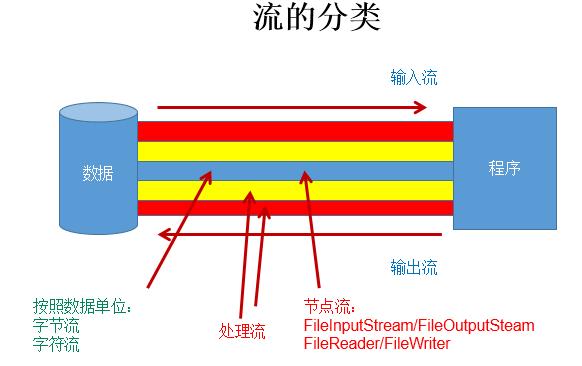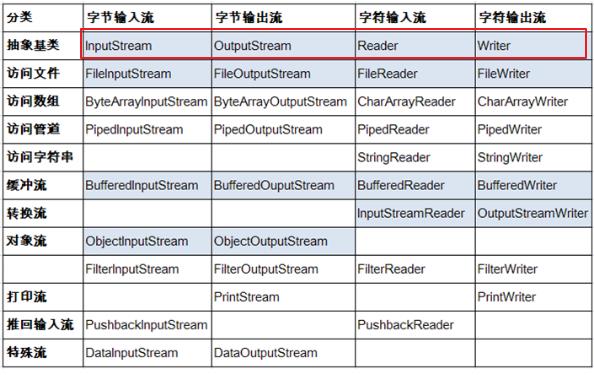Java自用高级编程-6.I/O流
Posted 王六六的IT日常
tags:
篇首语:本文由小常识网(cha138.com)小编为大家整理,主要介绍了Java自用高级编程-6.I/O流相关的知识,希望对你有一定的参考价值。
I/O流

一、File类的使用
1.File类的理解
- File类的一个对象,代表一个文件或一个文件目录(俗称:文件夹)
- File类声明在java.io包下
- File类中涉及到关于文件或文件目录的创建、删除、重命名、修改时间、文件大小等方法,并未涉及到写入或读取文件内容的操作。如果需要读取或写入文件内容,必须使用IO流来完成。
- 后续File类的对象常会作为参数传递到流的构造器中,指明读取或写入的"终点".
2.File的实例化
常用构造器
File(String filePath)
File(String parentPath,String childPath)
File(File parentFile,String childPath)
路径的分类
- 相对路径:相较于某个路径下,指明的路径。
- 绝对路径:包含盘符在内的文件或文件目录的路径
说明:
-
IDEA中:
- 如果开发使用JUnit中的单元测试方法测试,相对路径即为当前Module下。
- 如果使用main()测试,相对路径即为当前的Project下。
-
Eclipse中:
- 不管使用单元测试方法还是使用main()测试,相对路径都是当前的Project下。
路径分隔符
windows和DOS系统默认使用“\\”来表示
UNIX和URL使用“/”来表示
3.File类的常用方法
File类的获取功能:
public String getAbsolutePath():获取绝对路径
public String getPath() :获取路径
public String getName() :获取名称
public String getParent():获取上层文件目录路径。若无,返回null
public long length() :获取文件长度(即:字节数。不能获取目录的长度。
public long lastModified() :获取最后一次的修改时间,毫秒值
如下的两个方法适用于文件目录:
public String[] list() :获取指定目录下的所文件或者文件目录的名称数组
public File[] listFiles() :获取指定目录下的所文件或者文件目录的File数组
File类的重命名功能:
public boolean renameTo(File dest):把文件重命名为指定的文件路径
比如:file1.renameTo(file2)为例:
要想保证返回true,需要file1在硬盘中是存在的,且file2不能在硬盘中存在。
File类的判断功能: 记得先调用exists()
public boolean isDirectory():判断是否是文件目录
public boolean isFile() :判断是否是文件
public boolean exists() :判断是否存在
public boolean canRead() :判断是否可读
public boolean canWrite() :判断是否可写
public boolean isHidden() :判断是否隐藏
File类的创建功能:
创建硬盘中对应的文件或文件目录
public boolean createNewFile() :创建文件。若文件存在,则不创建,返回false
public boolean mkdir() :创建文件目录。如果此文件目录存在,就不创建了。如果此文件目录的上层目录不存在,也不创建。
public boolean mkdirs() :创建文件目录。如果此文件目录存在,就不创建了。如果上层文件目录不存在,一并创建
File类的删除功能:
删除磁盘中的文件或文件目录
public boolean delete():删除文件或者文件夹
删除注意事项:Java中的删除不走回收站。
public class FileTest {
/*
1.如何创建File类的实例
File(String filePath)
File(String parentPath,String childPath)
File(File parentFile,String childPath)
2.
相对路径:相较于某个路径下,指明的路径。
绝对路径:包含盘符在内的文件或文件目录的路径
3.路径分隔符
windows:\\\\
unix:/
*/
@Test
public void test1(){
//构造器1
File file1 = new File("hello.txt"); //相对于当前module
File file2 = new File("G:\\\\Java\\\\workspace_idea1\\\\JavaSenior\\\\day08\\\\he.txt");
System.out.println(file1);
System.out.println(file2);
//构造器2:
File file3 = new File("G:\\\\Java\\\\workspace_idea1","JavaSenior");
System.out.println(file3);
//构造器3:
File file4 = new File(file3,"hi.txt");
System.out.println(file4);
}
/*
File类的获取功能:
public String getAbsolutePath():获取绝对路径
public String getPath() :获取路径
public String getName() :获取名称
public String getParent():获取上层文件目录路径。若无,返回null
public long length() :获取文件长度(即:字节数。不能获取目录的长度。
public long lastModified() :获取最后一次的修改时间,毫秒值
如下的两个方法适用于文件目录:
public String[] list() :获取指定目录下的所文件或者文件目录的名称数组
public File[] listFiles() :获取指定目录下的所文件或者文件目录的File数组
*/
@Test
public void test2(){
File file1 = new File("hello.txt");
File file2 = new File("G:\\\\Java\\\\io\\\\hi.txt");
System.out.println(file1.getAbsolutePath());
System.out.println(file1.getPath());
System.out.println(file1.getName());
System.out.println(file1.getParent());
System.out.println(file1.length());
System.out.println(new Date(file1.lastModified()));
System.out.println();
System.out.println(file2.getAbsolutePath());
System.out.println(file2.getPath());
System.out.println(file2.getName());
System.out.println(file2.getParent());
System.out.println(file2.length());
System.out.println(file2.lastModified());
}
@Test
public void test3(){
File file = new File("G:\\\\Java\\\\workspace_idea1\\\\JavaSenior");
System.out.println("***********文件名如下************");
String[] list = file.list();
for(String s : list){ //增强for循环
System.out.println(s);
}
System.out.println();
System.out.println("******文件路径如下************");
File[] files = file.listFiles();
for(File f : files){
System.out.println(f);
}
}
File类的重命名功能:
public boolean renameTo(File dest):把文件重命名为指定的文件路径
比如:file1.renameTo(file2)为例,要想保证返回true,需要file1在硬盘中是存在的,且file2不能在硬盘中存在。
@Test
public void test4(){
File file1 = new File("hello.txt");
File file2 = new File("G:\\\\Java\\\\io\\\\hi.txt");
boolean renameTo = file1.renameTo(file2);
System.out.println(renameTo);
}
File类的判断功能: 记得先调用exists()
public boolean isDirectory():判断是否是文件目录
public boolean isFile() :判断是否是文件
public boolean exists() :判断是否存在
public boolean canRead() :判断是否可读
public boolean canWrite() :判断是否可写
public boolean isHidden() :判断是否隐藏
@Test
public void test5(){
File file1 = new File("hello.txt");
file1 = new File("hello1.txt");
System.out.println(file1.isDirectory());
System.out.println(file1.isFile());
System.out.println(file1.exists());
System.out.println(file1.canRead());
System.out.println(file1.canWrite());
System.out.println(file1.isHidden());
System.out.println();
File file2 = new File("G:\\\\Java\\\\io");
file2 = new File("G:\\\\Java\\\\io1");
System.out.println(file2.isDirectory());
System.out.println(file2.isFile());
System.out.println(file2.exists());
System.out.println(file2.canRead());
System.out.println(file2.canWrite());
System.out.println(file2.isHidden());
}
File类的创建功能: 创建硬盘中对应的文件或文件目录
public boolean createNewFile() :创建文件。若文件存在,则不创建,返回false
public boolean mkdir() :创建文件目录。如果此文件目录存在,就不创建了。如果此文件目录的上层目录不存在,也不创建。
public boolean mkdirs() :创建文件目录。如果此文件目录存在,就不创建了。如果上层文件目录不存在,一并创建
File类的删除功能: 删除磁盘中的文件或文件目录
public boolean delete():删除文件或者文件夹
删除注意事项:Java中的删除不走回收站。
@Test
public void test6() throws IOException {
File file1 = new File("hi.txt");
if(!file1.exists()){ //创建之前判断一下
//文件的创建
file1.createNewFile();
System.out.println("创建成功");
}else{//文件存在
file1.delete();
System.out.println("删除成功");
}
}
@Test
public void test7(){
//文件目录的创建
File file1 = new File("G:\\\\Java\\\\io\\\\io1\\\\io3");
boolean mkdir = file1.mkdir();
if(mkdir){
System.out.println("创建成功1");
}
File file2 = new File("G:\\\\Java\\\\io\\\\io1\\\\io4");
boolean mkdir1 = file2.mkdirs();
if(mkdir1){
System.out.println("创建成功2");
}
//要想删除成功,io4文件目录下不能子目录或文件
File file3 = new File("G:\\\\Java\\\\io\\\\io1\\\\io4");
//file3 = new File("G:\\\\Java\\\\io\\\\io1\\\\io4");
System.out.println(file3.delete());
}
}
二、IO流概述
1.流的分类
- 操作数据单位:字节流、字符流
- 数据的流向:输入流、输出流
- 流的角色:节点流、处理流
图示:

2.流的体系结构

说明:红框对应的是IO流中的4个抽象基类。
蓝框的流需要重点关注。
3.重点说明的几个流结构

4.输入、输出的标准化过程
输入过程
① 创建File类的对象,指明读取的数据的来源。(要求此文件一定要存在)
② 创建相应的输入流,将File类的对象作为参数,传入流的构造器中
③ 具体的读入过程:创建相应的byte[] 或 char[]。
④ 关闭流资源
说明: 程序中出现的异常需要使用try-catch-finally处理。
输出过程
① 创建File类的对象,指明写出的数据的位置。(不要求此文件一定要存在)
② 创建相应的输出流,将File类的对象作为参数,传入流的构造器中
③ 具体的写出过程:write(char[]/byte[] buffer,0,len)
④ 关闭流资源
说明: 程序中出现的异常需要使用try-catch-finally处理。
三、节点流(或文件流)
FileReader/FileWriter的使用:
FileReader的使用
将hello.txt文件内容读入程序中,并输出到控制台
说明点:
- read()的理解:返回读入的一个字符。如果达到文件末尾,返回-1
- 异常的处理:为了保证流资源一定可以执行关闭操作。需要使用
try-catch-finally处理 - 读入的文件一定要存在,否则就会报
FileNotFoundException。
@Test
public void testFileReader1() {
FileReader fr = null;
try {
//1.File类的实例化
File file = new File("hello.txt");
//2.FileReader流的实例化
fr = new FileReader(file);
//3.读入的操作
//read(char[] cbuf):返回每次读入cbuf数组中的字符的个数。如果达到文件末尾,返回-1
char[] cbuf = new char[5];
int len;
while((len = fr.read(cbuf)) != -1){
//方式一:
//错误的写法
// for(int i = 0;i < cbuf.length;i++){
// System.out.print(cbuf[i]);
// }
//正确的写法
// for(int i = 0;i < len;i++){
// System.out.print(cbuf[i]);
// }
//方式二:
//错误的写法,对应着方式一的错误的写法
// String str = new String(cbuf);
// System.out.print(str);
//正确的写法
String str = new String(cbuf,0,len);
System.out.print(str);
}
} catch (IOException e) {
e.printStackTrace();
} finally {
if(fr != null){
//4.资源的关闭
try {
fr.close();
} catch (IOException e) {
e.printStackTrace();
}
}
}
}
FileWriter的使用
从内存中写出数据到硬盘的文件里。
说明:
- 输出操作,对应的File可以不存在的。并不会报异常
- File对应的硬盘中的文件如果不存在,在输出的过程中,会自动创建此文件。
- File对应的硬盘中的文件如果存在:
- 如果流使用的构造器是:
FileWriter(file,false) / FileWriter(file):对原文件的覆盖 - 如果流使用的构造器是:
FileWriter(file,true):不会对原文件覆盖,而是在原文件基础上追加内容
- 如果流使用的构造器是:
@Test
public void testFileWriter() {
FileWriter fw = null;
try {
//1.提供File类的对象,指明写出到的文件
File file = new File("hello1.txt");
//2.提供FileWriter的对象,用于数据的写出
fw = new FileWriter(file,false);
//3.写出的操作
fw.write("I have a dream!\\n");
fw.write("you need to have a dream!");
} catch (IOException e) {
e.printStackTrace();
} finally {
//4.流资源的关闭
if(fw != null){
try {
fw.close();
} catch (IOException e) {
e.printStackTrace();
}
}
}
}
文本文件的复制:
@Test
public void testFileReaderFileWriter() {
FileReader fr = null;
FileWriter fw = null;
try {
//1.创建File类的对象,指明读入和写出的文件
File srcFile = new File("hello.txt");
File destFile = new File("hello2.txt");
//不能使用字符流来处理图片等字节数据
// File srcFile = new File("爱情与友情.jpg");
// File destFile = new File("爱情与友情1.jpg");
//2.创建输入流和输出流的对象
fr = new FileReader(srcFile);
fw = new FileWriter(destFile);
//3.数据的读入和写出操作
char[] cbuf = new char[5];
int len;//记录每次读入到cbuf数组中的字符的个数
while((len = fr.read(cbufJava自用高级编程-8.反射机制